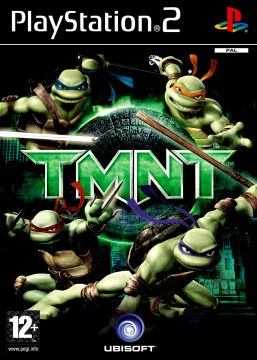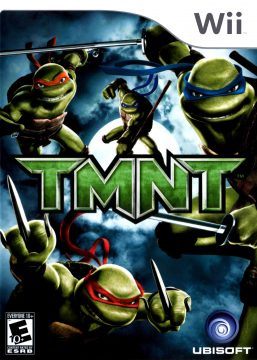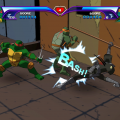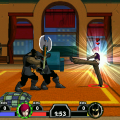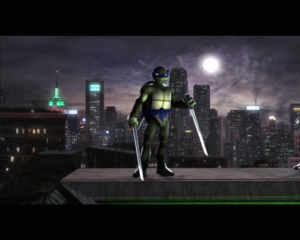- Teenage Mutant Ninja Turtles (NES)
- Teenage Mutant Ninja Turtles: The Arcade Game
- Teenage Mutant Ninja Turtles: World Tour
- Teenage Mutant Ninja Turtles: The Manhattan Missions
- Teenage Mutant Ninja Turtles III: The Manhattan Project
- Teenage Mutant Ninja Turtles: Turtles in Time
- Teenage Mutant Ninja Turtles: Hyperstone Heist
- Teenage Mutant Ninja Turtles: Fall of The Foot Clan
- Teenage Mutant Ninja Turtles II: Back From The Sewers
- Teenage Mutant Ninja Turtles III: Radical Rescue
- Teenage Mutant Ninja Turtles: Tournament Fighters (Genesis)
- Teenage Mutant Ninja Turtles: Tournament Fighters (SNES)
- Teenage Mutant Ninja Turtles: Tournament Fighters (NES)
- Teenage Mutant Ninja Turtles (Console – 2003)
- Teenage Mutant Ninja Turtles (GBA – 2003)
- Teenage Mutant Ninja Turtles 2: Battle Nexus (Consoles)
- Teenage Mutant Ninja Turtles 2: Battle Nexus (GBA)
- Teenage Mutant Ninja Turtles: Mutant Melee
- Teenage Mutant Ninja Turtles 3: Mutant Nightmare (Console)
- TMNT (2007) – Console
- TMNT (2007) – NDS and PSP
- Teenage Mutant Ninja Turtles 3: Mutant Nightmare (DS)
- TMNT (GBA)
- Teenage Mutant Ninja Turtles: Smash-Up
- Teenage Mutant Ninja Turtles: Arcade Attack
- Teenage Mutant Ninja Turtle (Plug and Play)
- Teenage Mutant Ninja Turtles Fast Forward: Ninja Training NYC / TMNT: Power of 4
- TMNT: Ninja Adventures – Mini-Game and Activity Centre
- Teenage Mutant Ninja Turtles: The Ninja Tribunal / The Shredder Reborn
- Teenage Mutant Ninja Turtles: Double Damage
Even before the production of the third live action movie in 1993, there were already plans of more movies to follow it and ride the popularity of the TMNT on the silver screen, but when that film turned into such a disaster, the fan base was soured and any further plans to finance and produce any motion pictures was put on ice or entirely scrapped, leaving the many script treatments and pitches in development hell for 12 years. It wasn’t until the successful relaunch in 2003 that investors were again willing to put their money towards a new blockbuster. Amidst many rumors of reboots, sequels, live action and animated features, Kevin Munroe was appointed to bring the green greats back to the big screen. Munroe had his background in video games, having been the lead director and artist on Midway’s Freaky Flyers in 2003.
Interestingly, the new TMNT movie was actually to be set in the same timeline as the three previous live action movies, though mostly ignoring the third movie in its narrative. Opting for a full CGI adventure rather than the mix of special effects costumes and live action actors, the new cinematic adventure brought back the grit and the real emotion to a TMNT movie, taking place several years after the events of the previous movies, with the four brothers having drifted apart and doing separated business. The result was surprisingly decent, with a well made action movie for all ages, with great voice acting and a real sense of family and the importance of the bond a family share and the turmoil that grows when that unit is taken apart. The film managed to bring the TMNT into contemporary times and age them along with the audiences that had grown up with them while also touching on subjects like teenage angst, regrets and responsibilities, essentially humanizing the characters and allowing for a broader audience to identify themselves with the characters, and also allowing for new parents that had grown up with the Ninja Turtles to introduce them to their own kids or younger family. The movie, simply dubbed TMNT, went on to be number one at the box office and a huge worldwide success on home video, and spawned a large line of merchandising, including an official video game.
After Konami’s last hurrah, Ubisoft became the license holder and quickly announced their plans to develop many new TMNT based games with their new acquisition. At the same day the first official poster images and promotional materials for the movie was released to the public, Ubisoft’s video game tie-in was also revealed, promising a dark NYC adventure based on the events of the movie and with cooperation from Munroe and Mirage. During the earlier demonstrations of the game, it was demoed on PS3 and Xbox 360 at conventions and sneak peaks, detailing plans of a co-op action adventure game using a similar visual style to that found in the movie. In addition to the action, there was also to be a great focus on the relationship between the brothers through the storyline.
TMNT takes place before and during the events of the film, allowing for a unique opportunity to explore and take part in each of the four brothers’ endeavors while they cope with reality of growing up and becoming separated and their journey to reunite once again. Rather than using the scenes taken out of the movie itself, all the cutscenes and story elements are scripted for the game exclusively and told in a past tense by the characters, reflecting on their individual times and struggles and seen through moving pictures in a comic book with art based on a blend of Mirage and new animated features art style. Due to the fact that the game was released before the actual movie and developed in way to tie the circumstances not seen in the actual movie together, there are some obvious deviances from how the movie turned out and played out. The game also made use of an original voice cast for the supporting cast rather than the one found in the movie, leading to slightly different role interpretations for some of the main characters interacting with the Ninja Turtles.
The stages are built up of a mix of acrobatic platforming with death defying leaps and wall running, melee combat and some slight interactive story devices which takes place literally all over the world as each stage tell a story from a perspective of one of the turtles, much in the style of a inner comic book dialogue.
The platforming portions make up the majority of the game, and are quite apparently inspired by Ubisoft’s reboot of Prince of Persia, which at the time of its release introduced the acrobatic platforming mechanics that is much more stylized in this game. Wall running, high climbing, double jumps and scenic acrobatics with the use of pipes and poles are featured on virtually every stage. Similar to the way it is displayed in the actual movie, the leaner, gecko like movements of the Ninja Turtles make them flow with efficiency and speed in a very appealing fashion. Stages are marched on a linear path with a fixed camera which in theory is there to give every area a more distinct feel and look to make the jumps and gymnastics less repetitive and to give the overall game a cinematic feel. Most of the actions are performed by a single button press along with the D-pad. Each turtle also bring individual skills that are used on their particular stages to give some variety. Some areas will also require the brothers to work together to perform slingshots and other team up moves to progress.
The combat takes place on set locations on each stage and will will lock the character in a small area, with the camera zooming in and the picture being given black bars to focus in on the characters rather than the environment. Combat is quite simple in its implementation, with a single button acting as a strike button perform a sequence of strikes, while the alternative attack button performs a jumping split kick which is used to mostly distance a group of enemies apart. Each turtle also has an individual charge up move, that can be performed when the meter is full to activate a rage mode which will distort the image and mostly take out all foes with one strike. Also during combat, brothers can be summoned to perform team up moves.
At a total of 16 stages, challenge stages can be unlocked to gain extras such as videos and artwork, as well as cheat modes that can be activated from its own menu. Like the Konami games of the 2k3 series, stages can be replayed and some stages act as boss stages. Completing stages brings up a ranking system based on teamwork, speed and combat with higher ranks resulting in unlocked secrets.
On the positive side of things, the fundamental game is quite solid and all the features work very well, especially the platforming sections, which are genuinely fun and fluid. The controls are quite responsive and easy to figure out, and even in its simplicity it is taught very well during the tutorial stages early on in the game. The new character design for the Turtles also gives them a bit of an advantage for a video game of this kind, with their lean and mobile physiques making the wall bounding and pole swinging much more appropriate than the beefed stocky design which has predominantly been used for the Ninja Turtles. The animation is also quite smooth and gives the game a heightened sense of speed without losing track of the actual character.
On the negative side however, TMNT never attempts to go further than the norm. At no point does the game present anything that would impress any general gamer or innovate any of the mechanics that already are more or less lifted from another famous franchise. The difficulty is also much too generous, as the game actually does not allow one to die, rather defeat will simply restart the segment, be it platforming or battle, and just deduct some amount of time which affects the ranking. The challenge never seems to pick up much at any point, even after the tutorial stages which even for the very youngest audience is much too easy. The fixed camera system tries to keep the progress interesting by introducing some new angles and panning over and under some interesting rooftop leaping jumps, but it introduces some very annoying issues of placing itself behind a railing or structure, obstructing the view and making some rather simple jumps frustrating due to the lack of a good angle to get some sort of perspective on how to position the jump.
Additionally, for all the talk of teamwork and emphasis on brotherhood as stated in the development period of the game, the actual finished product features no multiplayer capabilities and the use of teamwork in game is reserved for very few moments of effectiveness, while outside of those moments there is no need to call upon any shelled brother. Similarly, combat is extremely repetitive and overly simplistic, with the same string of strikes never evolving and enemies more or less just standing around waiting to be attacked and never posing a threat. The boss battles are also quite disappointing and don’t change up things enough to keep the interest up. It goes into the initial problem with the game, it never allows itself to step up out of the ordinary.
Even though the game was mostly demoed on the then next generation line of consoles such as PS3 and Xbox 360, the actual graphics are somewhat disappointing for its time apart from the interesting turtle design. The character modeling and animation is acceptable, but the actual geometry of each stage is lacking, with quite ugly scenery and blocky shapes, which at times can be almost to the point that they are undefinable. For the major set pieces this isn’t as much of an issue, but it really jars the eyes when a rock shows on the side of the trail that consists of four pointy shapes and a two toned texture which sticks out from the otherwise fairly appealing stages. The composition of each stage also becomes a bit old halfway through no matter how much the camera pans and curves along, and relies too much on rubble and grey buildings for its own good. The framerate also takes a hit during some of the boss battles, though not to an extent it really detracts too much. The audio is entirely forgettable as well, consisting of simple ambience and rock riffs. The voice clips also repeats too often which becomes quite annoying quite quickly.
So TMNT is quite the mixed experience. On one hand, it works for what it does and can’t be said to be outright mediocre, because the platforming is genuinely fun and it’s only towards the very end that one really would start to feel a bit of fatigue from those mechanics. The controls are also rewarding due to the speed of the game, and the feeling of running along a wall, double jumping and dropping down only to catch onto a pipe and perform a flashy flip is a feeling only Jackie Chan can identify with. The problems really boils down to the cowardly approach by the developers to never let the Ninja Turtles come out of their shells and really bring some action to the table, and rather just placing them in essentially what feels like Prince of Persia lite version. Even the very youngest of players will have no problems running through the stages considering battle is mostly just a one button affair, and that the turtles can’t be defeated in the traditional sense. For fans of the movie, it gives a cool insight into the characters and their individual struggles and thoughts, but for those who just come into the game without any prior interest, the story elements will most likely just serve to confuse. If bought at a bargain price, it’s a totally acceptable game however.
TMNT appeared on virtually every system of its time, with the console versions and the PC version being identical apart from some graphical changes and control layouts. Judging from the graphics, the GameCube and Wii versions seems to have been the actual lead development units due to the fact that they feature the least bit of slowdown during any given boss battle and that the higher capable versions still uses most of the textures found in those games. The Wii version stands out the most due to its implementation of motion controls, though these controls are quite unfavorable due to being largely just waggle without any rationale or imitation of the on screen action. On top of being lazily implemented, there is also a delay between the actual motion and the reaction in game. There are some exclusive minigames in the Wii version based around the pointer controls, which actually works relatively well, but they don’t serve to really flesh out the experience enough to warrant a purchase. The GameCube version features identical graphics to the Wii game, though the controls are much more preferable and the best out of all the alternatives. The PlayStation 2 version features weaker graphics and more frame rate issues than any other version, and is not to be recommended compared to the GameCube version.
The PC version and Xbox 360 seems to be the very same, with the highest graphical option of the PC being the same of that found in the 360 game. Underwhelmingly, the graphics are simply presented at a higher resolution, while the texturing remains the same as the SD versions, which leads to some very ugly compression on some of the areas and quite visual leap compared to the other games released in 2007 on 360 and PC and making it one of the few games which looks more or less the same on both 360 and Wii. Some areas have been touched up however, and character models have some additional reflection effects on them, but for some reasons these upgrades are very few, possibly due to time restrictions. The 360 version has some achievements not found in any other of the versions, though they are very easily obtained and require little effort to be achieved.
Strangely despite the game being demoed on PlayStation 3 at several media briefings and conventions, TMNT never saw any release on that console and was silently cancelled without any explanation.


